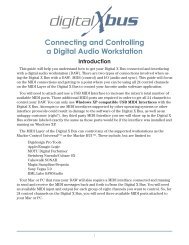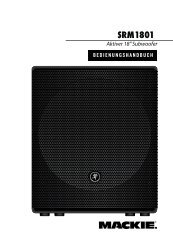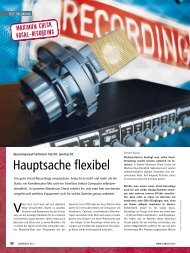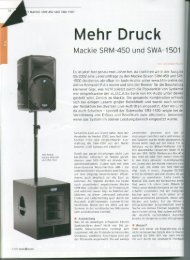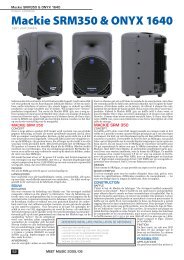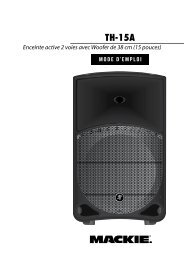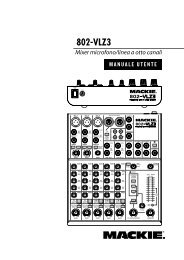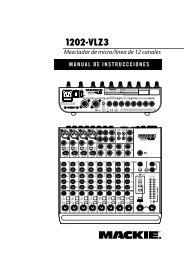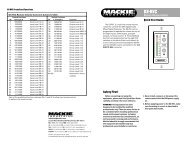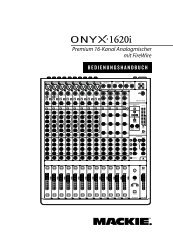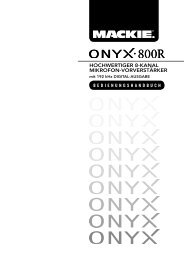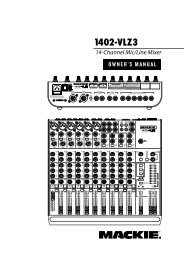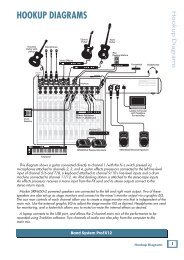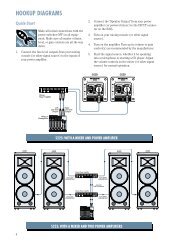Create successful ePaper yourself
Turn your PDF publications into a flip-book with our unique Google optimized e-Paper software.
Review<br />
ONYX<br />
Satellite<br />
Portable<br />
Recording<br />
System<br />
The choice of digital/audio interfaces and<br />
software packages for the musician/<br />
engineer is now pretty diverse (to understate the matter<br />
completely). As a user and reviewer of audio gear I love to play with new<br />
toys and I have to say that, having played with a large number of<br />
interfaces, pretty much all of them do their job well. But every now and<br />
then I get to play with a new toy that’s not a toy at all and that soars way<br />
above the rest. This review is about just such a joy device.<br />
My first encounter with the term ONYX was when reviewing the<br />
<strong>Mackie</strong> 24.4 live console. I recall commenting that with the specs and<br />
sound quality of this circuitry the 24.4 was equivalent in sound and<br />
quality to a top studio recording/mixing desk. Now it seems that <strong>Mackie</strong><br />
have combined these technologies into something completely useful for<br />
Page 16 NZM June/July 2007<br />
the mobile/home recordist.<br />
The <strong>Mackie</strong> ONYX Satellite portable Firewire<br />
recording system is a complete recording/mixing solution featuring a<br />
two input channel recording desk with a deatchable preamp module.<br />
Although it comes bundled with Tracktion 2 software the system is<br />
designed to work with any ASIO or Core Audio compatible application –<br />
which is pretty much most platforms these days. The package works on<br />
either Mac or PC – for purposes of this review I used an iBook G4, running<br />
system 10.4.9, with 1GB RAM. The full version of Tracktion 2 software is<br />
essentially a fully-fledged recording/mixing/mastering solution. I have to<br />
say that installing the system on my Mac was extremely straightforward<br />
– the description of PC installation in the manual seemed considerably<br />
more complex.<br />
Reviewed by Sam Airy<br />
The unit itself is the most unusual 2-channel recording solution I have<br />
ever seen, but after a week of play I can attest that it is also probably the<br />
most comprehensive of its ilk available today. The centre section is what<br />
most musician/engineers would recognise as their standard mic pre<br />
digital audio interface. The fact that this interface then slots seamlessly<br />
into a Base Station with features that that you’d normally associate with<br />
a control room console is what sets it apart.<br />
The satellite unit is a 2-channel, phantom powered interface weighing<br />
a little more than a standard block of butter, with front panel mic/line<br />
selectors and knobs alongside independent LED level monitoring for<br />
each channel. In addition there are two 1 /4 inch jack headphone sockets<br />
with independent level controls. On the rear are two combo jack/XLR<br />
inputs with separate left and right control room (speaker) outputs that<br />
accept TS or TRS jacks.There are also Firewire and 48 pin docking sockets.<br />
It’s via this last connector that the satellite connects to the base<br />
station, so there’s nothing to line up, no pins to bend, it just slots straight<br />
in. The rear panel of the base station has the types of features you’d only<br />
expect on a control room console… insert points, balanced TRS and XLR<br />
inputs, output for two sets of monitors for A/Bing, and even a talkback<br />
system complete with built-in mic. With labels such as CR (control room)<br />
Out <strong>Mackie</strong>’s intentions are clearly that the base station is to be used as a<br />
fixed studio installation. Overall the ONYX Satellite has specs that rival<br />
any digital audio interface.With up to 24bit/96kHz sampling,103dBu (mic<br />
to line out) dynamic range and a typical Equivalent Input Noise (EIN) of -<br />
110dBu @+60dB gain. This also rates as a professional device with a<br />
+4dBu standard operating level.<br />
From the moment I turned the unit on I knew we were off to a good<br />
start. My studio is dark even when it’s lit and with the power switch<br />
conveniently on the front panel there’s no fumbling around at the back<br />
for a change. The buttons have a proper professional feel, not the soft
ubber variety which bend over as they sink down. The first<br />
set on the left of the unit give access to the instrument line<br />
inputs, which turn out to be a huge blessing. Normally if you<br />
plug a guitar straight into line inputs the tops will be<br />
missing by the time it gets to record software and a DI<br />
needs to be used as a work around. <strong>Mackie</strong> have got this<br />
one completely sussed. Insert points are something so<br />
many home recordists don’t know they’re missing. I have<br />
never used a software plug-in that was able to adequately<br />
compress a signal to disc. Surely, the only proper way to<br />
achieve this is by compression before the signal reaches the<br />
software and this is something that <strong>Mackie</strong> appear to<br />
understand well.<br />
My one honest gripe is that the talk back facility might<br />
be rather ambitious for such a unit. It seems unlikely that<br />
Satellite users will have an entire control room and separate<br />
studio and only want to record two simultaneous<br />
tracks of audio. Today many recording engineers<br />
will use the control room and not the studio<br />
where quick takes need to be recorded. Sure, the<br />
To DAW button means that one can ‘slate’ spoken<br />
documentation about the track to disk, but such<br />
documentation can these days readily be<br />
included in filenames and track info found in<br />
most recording applications.<br />
It’s all too easy to forget that this not really an<br />
analogue unit. Signals do not pass through an<br />
analogue buss for routing purposes. Much of the<br />
process is digital – and that’s without the<br />
software! This means that precise gain structure<br />
must be observed and when those red O/L lights<br />
come on – it really is time to consider backing off<br />
a little. The sound coming off those ONYX mic<br />
preamps just glistens with energy. For me, the<br />
whole thing is worth it just for this alone… and<br />
on top of that there’s the really useful stuff like<br />
the Tracktion software!<br />
<strong>Mackie</strong> have taken a particularly exciting<br />
direction with the ONYX satellite. I have used<br />
many dedicated all-in-one solutions over the<br />
years and there’s definitely a point to having a<br />
permanent set-up that is there to do just one<br />
thing very well. Conversely, hardened users of<br />
dedicated software systems can mix in the<br />
bathtub if they’re careful, however their system is<br />
not set up to work as an integrated recording<br />
studio. The ONXY comes one step closer to<br />
bridging this gap by allowing musicians the<br />
freedom to roam, whilst reminding them that<br />
they are also de facto audio engineers.<br />
In the past it has been easy to return a mic<br />
preamp digital audio interface; unplug it, re-box<br />
it, return it. But with the ONYX satellite system it<br />
became necessary to dismantle a very functional,<br />
brilliant sounding recording studio (bugger!).<br />
Tellingly, the moment I reconnected some of my Experience the latest in portable audio recording at Sound Techniques today.<br />
other gear and recorded several tracks alongside Your best selection in <strong>New</strong> <strong>Zealand</strong> including HHB, Sound Devices, Lectrosonics, Marantz,<br />
those from the ONYX Satellite I had one of those<br />
Fostex and more. Equipment sales and rentals, including lease-to-own finance.<br />
moments of complete clarity… I had just taken a<br />
big backward step. Time for an ONYX, me thinks.<br />
For information, email us at info@soundtq.co.nz or call (09) 366 1750.<br />
Sam Airy is an Auckland-based composer,<br />
conductor and producer. By day he heads the Audio<br />
Engineering at MAINZ and specialises in lecturing in<br />
Studio Recording, Music Synthesis and Jingle<br />
Production.<br />
portable professional audio<br />
NZM June/July 2007<br />
we listen and give sound advice<br />
136B <strong>New</strong>ton Rd (cnr St Benedicts St), <strong>New</strong>ton, Auckland ph (09) 366 1750 www.soundtq.co.nz<br />
Page 17



